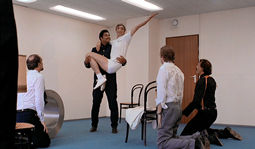In a Year With Thirteen Moons
By Chris Hyde
May 10, 2004
BoxOfficeProphets.com

Most of the press concerning the greatest director of the New German Cinema of the 1970s tosses around loaded terms like “enfant terrible," and it is indeed difficult to write about the blazing talent of this mercurial filmmaker without resorting to such rhetorical fancy. In his brief life, this celluloid provocateur wielded his art like a weapon, turning his steely gaze towards the tribulations of society with a cynical eye in a way that managed to raise the ire of both the right and the left in his native country. Unsparing in his criticism, Fassbinder’s work tends to let few escape his withering glances — including, often, even the director himself.
While there are many highlights among the 40-some odd films that the filmmaker made in his short time on the planet, none are nearly so personal as this one. Made just shortly after the suicide of his lover Armin Maier (an event which the director had a fair hand in), In a Year of Thirteen Moons was a project that Fassbinder undertook so as to get back on his feet after the tragic events of his personal life. Like so many other of his cinematic works, the movie deals in the main with the sorts of power games that exist in relationships both between people and with the society in which they find themselves — as well as the difficulty of transcending or escaping the role in which one finds oneself.
In a Year of Thirteen Moons centers around a character named Elvira (Volker Spengler) who has undergone a sex change operation only to be rejected by the man (Gottfried John) whose casual remark inspired the gender change. A violent incident in a park and a fight with Elvira’s current lover start off the film, and eventually lead to Elvira’s meeting up with a prostitute named Zora (played by luminous Fassbinder regular Ingrid Caven, in one of the best parts of her career). With Zora in tow, Elvira pores over the events of her existence, delineating her former job as a slaughterhouse worker (in a gruesome scene that is not for the faint of heart) and her orphaned upbringing in a local religious institution. Things eventually lead to Elvira revisiting the now powerful man for whom she has altered herself so completely; and this ultimately unhappy reunion leads inexorably to the desperate nature of the film’s final act.
While certainly not a film to watch when searching for a light evening of entertainment, In a Year of Thirteen Moons nevertheless maintains an air of sorrowful triumph that pervades its melodramatic framework. The movie is essentially plotless, with Fassbinder weaving an episodic celluloid tale that is much like Elvira’s rambling personal diary. And though the events that make up the story of this character’s life are tragic in nature, with Fassbinder in charge there are of course a few moments of humor and wrenching irony that help to mitigate the depressing nature of the film. Notable among these is one hilarious musical scene where the characters are suddenly caught up in reenacting a set piece from an old Dean Martin/Jerry Lewis movie (!).
As this project was Fassbinder’s means of getting back on his feet as an artist after the sad turn that his personal life had taken, he seized complete artistic control of nearly all aspects of the production. The auteur line in the opening credits that details his contributions to the film is lengthy and nearly total: direction, writing, production, art direction and editing, though Juliane Lorenz also had a hand in cutting the final product. Additionally, when usual Fassbinder cinematographer Michael Ballhaus was unavailable to do the camerawork, the filmmaker just went ahead and shot it all himself (and quite well, too). This utter immersion in the material is what helps to make this the one work of Fassbinder’s that truly personifies his cinematic approach; no other film in his canon cuts as close to the biographical bone as does this one.
Fantoma has issued a number of movies from the Fassbinder collection in digital form, but as this is one of the director’s great pieces of art they have happily included much more extra material than with previous releases. There’s a decent brief introduction to the film by Richard Linklater and liner notes by film scholar Robert Kolker that help to explicate the importance of In a Year of Thirteen Moons. There are also two video interviews with New German Cinema figure Werner Schroeter as well as editor Juliane Lorenz. Lorenz, who is heavily involved in the preservation and promotion of Fassbinder’s legacy, also lends herself to some nice commentary tracks on a few of the key scenes of the work which really go a long way towards aiding in a full understanding of this singular piece of cinema.
The widescreen presentation of In a Year of Thirteen Moons given here is in the main of good quality, and while the transfer isn’t completely spectacular it still does a right solid job of displaying Fassbinder’s gem with the proper verve. All in all then, this DVD release does a wonderful job of making what is possibly the German director’s greatest artistic achievement available domestically, and with the contributions of its auteur helmsman plus the amazing performances of Caven and Spengler the movie is as powerful today as it has ever been. It’s not a pretty picture of the world, to be sure, and many may find the raw emotion of the piece to be a bit full of despair for their tastes. But viewers who are willing to take in a little bit of anguish with their buttered popcorn will discover a dynamic document from a quite exceptional artist; there sure aren’t many films from the Continent of the time that can match this one’s scope or emotive impact.